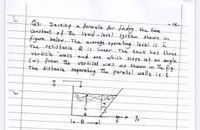
Introduction to Chemical Engineering Thermodynamics
8th Edition
ISBN: 9781259696527
Author: J.M. Smith Termodinamica en ingenieria quimica, Hendrick C Van Ness, Michael Abbott, Mark Swihart
Publisher: McGraw-Hill Education
expand_more
expand_more
format_list_bulleted
Question

Transcribed Image Text:14
farmula for findng the time
Constant of the liquid - level System shown in
figure below. The avenage operating level is h
The resistance Ris linear. The tank has three
verticle 'wolls and one which slope at an angle
Qsi Develop
fxt from the vertical wall
as Shown in The fig.
The distance separating the parallel walls is i
of
R
Expert Solution
This question has been solved!
Explore an expertly crafted, step-by-step solution for a thorough understanding of key concepts.
This is a popular solution
Trending nowThis is a popular solution!
Step by stepSolved in 2 steps with 2 images

Knowledge Booster
Learn more about
Need a deep-dive on the concept behind this application? Look no further. Learn more about this topic, chemical-engineering and related others by exploring similar questions and additional content below.Similar questions
- Consider a 10 m length of 2 cm-I.D tube. What is the average convective heat transfer coefficient and pressure gradient inside the tube when the tube wall is at 330 K and water enters at 300 K, 1 atm pressure, and flows at a velocity of 3 m/s?arrow_forwardon problem B equation 1) what symbol is that? it looks like a N or an X , can you tell me the symbols for transport velocities and mass transfer thanks can you clarify more on what the symbolism is for that equationarrow_forward2. Adjacent Flow of Two Immiscible Power Law Fluids Two immiscible fluids are contained in the space between two infinite parallel plates. The upper plate, at y = h, is in motion with a velocity U. Initially there is no pressure gradient in the x-direction. We have already solved for the velocity profile between the two plates for a number of different conditions, now we are going to make fluid II non-Newtonian. U Fluid II Interface Between Two Immiscible Fluids ah Fluid I d) Go back to your old assignment (b), but now let's let Fluid II be non-Newtonian. Specifically, model the fluid as a power law fluid with n =ky". Solve for the velocity profile across the channel and sketch the result for a shear thinning and shear thickening fluid as the velocity on the top plate is systematically increased. e) Now remove the velocity of the top plate and instead apply a pressure gradient. What is the velocity profile look like now?arrow_forward
- PROBLEM BACKGROUND The most common heat exchanger used in industry is a 'shell-and-tube' heat exchanger as illustrated in the figure. One fluid is fed into a set of tubes around which a second fluid is circulated. In the example shown, complex flow patterns illustrated by arrows show the flow may be partially parallel flow and partially crossflow. PROBLEM STATEMENT For this problem, we will consider a single tube in a crossflow configuration as shown. Air is to be heated to the desired temperature to feed a bioreactor. The air is feed flows normal to the outside of the center tube. Saturated steam is flows through the inside of the tube to provide the heat. The air is being fed at an average velocity of 15 m/s though the outer pipe of the heat exchanger at 27 °C and 1 atm. It heated by using saturated steam which condenses at 107°C over the surface of the inner tube. The tube is 5 m long with an outer diameter of 0.015 m and an inner diameter of 0.014 m. For simplicity in answering…arrow_forwardAccording to nature of flow, convective heat transfer is classified into natural convection and forced convection. By taking specific examples, explain how the natural convection and forced convection arises in them.arrow_forward
arrow_back_ios
arrow_forward_ios
Recommended textbooks for you
 Introduction to Chemical Engineering Thermodynami...Chemical EngineeringISBN:9781259696527Author:J.M. Smith Termodinamica en ingenieria quimica, Hendrick C Van Ness, Michael Abbott, Mark SwihartPublisher:McGraw-Hill Education
Introduction to Chemical Engineering Thermodynami...Chemical EngineeringISBN:9781259696527Author:J.M. Smith Termodinamica en ingenieria quimica, Hendrick C Van Ness, Michael Abbott, Mark SwihartPublisher:McGraw-Hill Education Elementary Principles of Chemical Processes, Bind...Chemical EngineeringISBN:9781118431221Author:Richard M. Felder, Ronald W. Rousseau, Lisa G. BullardPublisher:WILEY
Elementary Principles of Chemical Processes, Bind...Chemical EngineeringISBN:9781118431221Author:Richard M. Felder, Ronald W. Rousseau, Lisa G. BullardPublisher:WILEY Elements of Chemical Reaction Engineering (5th Ed...Chemical EngineeringISBN:9780133887518Author:H. Scott FoglerPublisher:Prentice Hall
Elements of Chemical Reaction Engineering (5th Ed...Chemical EngineeringISBN:9780133887518Author:H. Scott FoglerPublisher:Prentice Hall
 Industrial Plastics: Theory and ApplicationsChemical EngineeringISBN:9781285061238Author:Lokensgard, ErikPublisher:Delmar Cengage Learning
Industrial Plastics: Theory and ApplicationsChemical EngineeringISBN:9781285061238Author:Lokensgard, ErikPublisher:Delmar Cengage Learning Unit Operations of Chemical EngineeringChemical EngineeringISBN:9780072848236Author:Warren McCabe, Julian C. Smith, Peter HarriottPublisher:McGraw-Hill Companies, The
Unit Operations of Chemical EngineeringChemical EngineeringISBN:9780072848236Author:Warren McCabe, Julian C. Smith, Peter HarriottPublisher:McGraw-Hill Companies, The

Introduction to Chemical Engineering Thermodynami...
Chemical Engineering
ISBN:9781259696527
Author:J.M. Smith Termodinamica en ingenieria quimica, Hendrick C Van Ness, Michael Abbott, Mark Swihart
Publisher:McGraw-Hill Education

Elementary Principles of Chemical Processes, Bind...
Chemical Engineering
ISBN:9781118431221
Author:Richard M. Felder, Ronald W. Rousseau, Lisa G. Bullard
Publisher:WILEY

Elements of Chemical Reaction Engineering (5th Ed...
Chemical Engineering
ISBN:9780133887518
Author:H. Scott Fogler
Publisher:Prentice Hall


Industrial Plastics: Theory and Applications
Chemical Engineering
ISBN:9781285061238
Author:Lokensgard, Erik
Publisher:Delmar Cengage Learning

Unit Operations of Chemical Engineering
Chemical Engineering
ISBN:9780072848236
Author:Warren McCabe, Julian C. Smith, Peter Harriott
Publisher:McGraw-Hill Companies, The